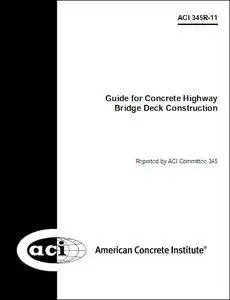ACI, "345R-11: Guide for Concrete Highway Bridge Deck Construction"
2011 | pages: 46 | ISBN: 0870314106 | PDF | 3,6 mb
2011 | pages: 46 | ISBN: 0870314106 | PDF | 3,6 mb
The deck of a highway bridge serves both structural and functional purposes for the structure. As a structural component, it provides the load path to safely transfer forces from wheel loads to the supporting superstructure and substructure elements. It may also contribute, through composite action, to the performance of primary superstructure components. Equally, the construction and condition of a deck directly impacts serviceability or the ability of the structure to safely and efficiently carry highway traffic by providing smoothness, skid resistance, and resistance to deflections under wheel loads. The riding surface of a highway bridge deck should provide a continuation of the pavement segments that it connects. The surface should be free from characteristics or profile deviations that impart objectionable or unsafe riding qualities. The desirable qualities should persist with minimum maintenance throughout the projected service life of the structure.
Roughness, cracking, spalling, scaling, and poor skid resistance are defects that result when the many details that influence their occurrence are not given sufficient attention. Recognition of the interaction of design, materials, and construction practices, as well as environmental factors, is the important first step in achieving smooth and durable decks.
Many decks remain smooth and free from surface deterioration and retain skid resistance for many years. When deficiencies occur, they usually take one of the forms described in this guide. The contribution of various aspects of deck construction to defects is discussed and guidelines based on theory and experience presented that should reduce the probabilities of occurrence to acceptable levels.
My Link



